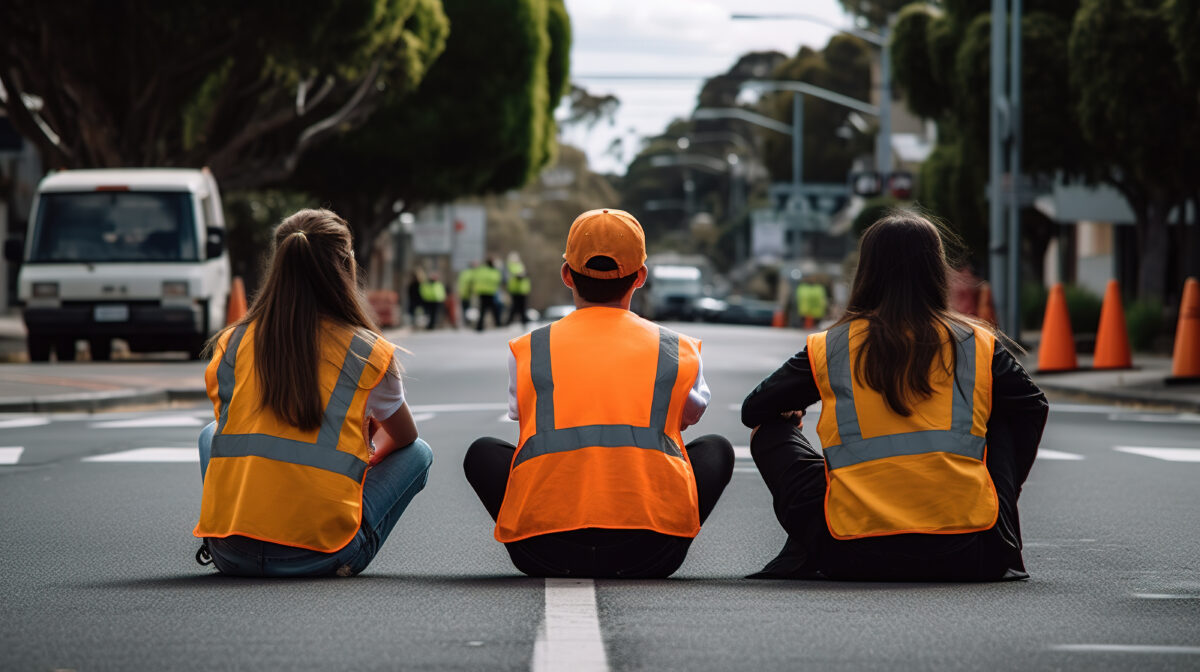Wearing bright blue t-shirts with their motivations for protesting written across the front — their kids, the future, and Earth itself — climate activists from the group Extinction Rebellion Boston stopped traffic in front of South Station on the morning of September 21.
More than 35 activists held signs and banners that read, “Governor Healey No New Fossil Fuels” and “No New Fossil Fuel Infrastructure” while cars weaved around them. Lasting for about 15 minutes, the protest ended with 15 arrests.
After the protest, Extinction Rebellion Boston, which advocates for banning new fossil fuel infrastructure, apologized to drivers on X, formerly known as Twitter, and said, “We’re blocking these roads because it’s proven to be the best way to actually change how our society approaches this disaster.”
“This disaster” refers to the death and destruction climate change is causing, such as the Canadian and Maui wildfires and the flash flood that hit New York City at the end of September. It is also in reference to the government’s lack of significant action, according to the statement.
While advocacy groups like Extinction Rebellion Boston believe that extreme actions of civil disobedience are necessary to enact change, it raises a question: Is civil disobedience necessary or counterproductive?
For instance, in a video posted on X, an activist can be heard explaining why the group was blocking the road. A driver replied, “I don’t give a s— … get the f— out of my way,” showing anger towards the activist rather than understanding, agreement, and interest.
The organization did acknowledge in their statement that they may have prevented drivers from getting to work, a doctor’s appointment, or an interview on time and that they gave them “a bad morning.” However, they may have discredited this by adding that the day was also difficult for themselves, explaining they do not enjoy spending mornings standing in front of cars.
This example draws attention to the extent activists are willing to go to support their mission without subsequently turning drivers and passersby away. It also raises questions: Did blocking traffic persuade anyone — either those stuck in the traffic, onlookers, or those on social media — to join their cause? What, at the end of the day, did this event truly achieve?
There is a phenomenon known as the activists’ dilemma that could help address these questions and determine whether activists’ actions are beneficial, or if there is a point at which activism can go too far and have a negative impact.
A 2020 study published in the Journal of Personality and Social Psychology, wrote that “extreme protest actions not only negatively affected attitudes toward the movement, but typically also reduced support for the movements’ central positions.”
Activist groups can reduce observers’ support for movements when protest actions are too extreme, according to the study. Such actions can include using inflammatory rhetoric, blocking traffic, and vandalism.
Extinction Rebellion is not the only group that believes civil disobedience is necessary for change, nor is it the only group that is willing to go to extreme lengths.
Just Stop Oil – a British environmental activist group demanding that the UK government stops licensing all new oil, gas, and coal projects – made the news last October after activists from the organization threw soup at Vincent Van Gogh’s Sunflowers and mashed potatoes at Claude Monet’s Grainstacks, leaving people more confused about why artwork from over 100 years ago was being targeted than supportive of the group’s mission.
Activists from other climate organizations – such as Last Generation in Germany – have also recently vandalized artwork, targeting pieces by artists such as Andy Warhol’s Campbell’s Soup Cans.
In general, these acts of vandalism were not well-received, and according to a study conducted at the University of Pennsylvania, both Republican and Democrat respondents said that these, and similar protests, made them less likely to support climate action. There is, however, no concrete evidence supporting the possibility that people’s perceptions of climate change positively shifted because of the protests.
Activists risk backlash with civil disobedience, but many see this as the only way to foster change. If they do not believe that speaking with lawmakers would be effective, then the question is: What is the most effective way to call attention to their cause, and, more importantly, encourage onlookers to change their views or perhaps even join their movement?
Sources:
Aton, F. (2022, November 18). Climate Activists Throw Flour on Warhol-Painted BMW Art Car in Milan. ARTnews.com. https://www.artnews.com/art-news/news/andy-warhol-bmw-climate-activists-protests-flour-1234647173/
Feinberg, M., Willer, R., & Kovacheff, C. (2020, January 13). The activist’s dilemma: Extreme protest actions reduce popular support for social movements. Psycnet.apa.org. https://psycnet.apa.org/record/2020-02398-001
https://twitter.com/XRBoston/status/1704839561887490503. (2023). X (Formerly Twitter). https://twitter.com/XRBoston/status/1704839561887490503
Nittle, N. (2021, February 19). The Activist’s Dilemma. Stanford Graduate School of Business. https://www.gsb.stanford.edu/insights/activists-dilemma
Patkin, A. (2023, September 21). Climate activists arrested after disrupting traffic in downtown Boston. Www.boston.com. https://www.boston.com/news/local-news/2023/09/21/climate-activists-arrested-after-disrupting-rush-hour-traffic-in-downtown-boston/
Seariac, H. (2022, November 18). Throwing food on artwork in climate protests may backfire, study finds. Deseret News. https://www.deseret.com/2022/11/18/23466594/just-stop-oil-art-protests-mona-lisa-van-gogh

